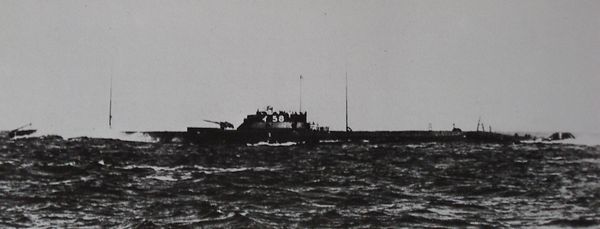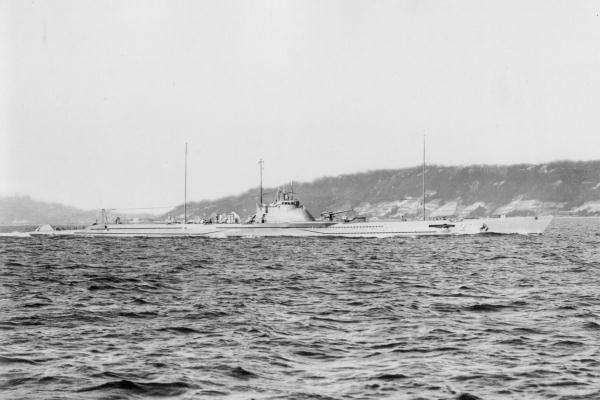Kaidai-class Submarine on:
[Wikipedia]
[Google]
[Amazon]
The was a type of first-class submarine operated by the
 Project number S22. The prototype for the class. The sole Kaidai I, ''I-51'', was based on
Project number S22. The prototype for the class. The sole Kaidai I, ''I-51'', was based on
 Project number S25. There was only 1 Kaidai II, ''I-152'' planned under the Eight-six fleet together with the ''I-51''. She was completed in 1924, used as a training vessel until mid-1942, then struck from service. She was scrapped in 1946.
*Boat in class
Project number S25. There was only 1 Kaidai II, ''I-152'' planned under the Eight-six fleet together with the ''I-51''. She was completed in 1924, used as a training vessel until mid-1942, then struck from service. She was scrapped in 1946.
*Boat in class
 Project number S26 (Kaidai IIIa) and S27 (Kaidai IIIb). The nine Kaidai IIIs were based on earlier designs, but featured a strengthened hull. The "IIIb" types were 40 cm longer and had a different bow design. All nine boats were constructed between 1927 and 1930.
Of the nine Kaidai IIIs, seven survived the war, as they spent much of their time as training vessels. These were scuttled or scrapped shortly after the end of World War II. ''I-63'' was sunk in a collision with ''I-60'' in 1939, the former losing all her crew. ''I-63'' was refloated and scrapped in 1940. ''I-60'' was later sunk by .
Project number S26 (Kaidai IIIa) and S27 (Kaidai IIIb). The nine Kaidai IIIs were based on earlier designs, but featured a strengthened hull. The "IIIb" types were 40 cm longer and had a different bow design. All nine boats were constructed between 1927 and 1930.
Of the nine Kaidai IIIs, seven survived the war, as they spent much of their time as training vessels. These were scuttled or scrapped shortly after the end of World War II. ''I-63'' was sunk in a collision with ''I-60'' in 1939, the former losing all her crew. ''I-63'' was refloated and scrapped in 1940. ''I-60'' was later sunk by .
 Project number S28. Slightly smaller than her predecessors and with only four
Project number S28. Slightly smaller than her predecessors and with only four
 Project number S31 (Kaidai VIa) and S34 (Kaidai VIb). They were built in 1931-34 under the 1st Naval Armaments Supplement Programme (''Maru'' 1) and the
Project number S31 (Kaidai VIa) and S34 (Kaidai VIb). They were built in 1931-34 under the 1st Naval Armaments Supplement Programme (''Maru'' 1) and the
Imperial Japanese Navy
The Imperial Japanese Navy (IJN; Kyūjitai: Shinjitai: ' 'Navy of the Greater Japanese Empire', or ''Nippon Kaigun'', 'Japanese Navy') was the navy of the Empire of Japan from 1868 to 1945, when it was dissolved following Japan's surrender ...
(IJN) before and during World War II
World War II or the Second World War, often abbreviated as WWII or WW2, was a world war that lasted from 1939 to 1945. It involved the World War II by country, vast majority of the world's countries—including all of the great power ...
. The type name was shortened to Navy Large Type Submarine.
All ''Kaidai''-class submarines originally had a two-digit boat name, from ''I-51'' onwards. On 20 May 1942, all Kaidai submarines added a '1' to their names. For example, ''I-52'' became ''I-152''. Ships are listed by the three-digit boat name if they had one, two-digit if they were not granted one or left service before 20 May 1942.
Class variants
The ''Kaidai''-type submarines were divided into seven classes and two subclasses: * * * * * * * * *Kaidai I (''I-51'' class)
 Project number S22. The prototype for the class. The sole Kaidai I, ''I-51'', was based on
Project number S22. The prototype for the class. The sole Kaidai I, ''I-51'', was based on World War I
World War I (28 July 1914 11 November 1918), often abbreviated as WWI, was List of wars and anthropogenic disasters by death toll, one of the deadliest global conflicts in history. Belligerents included much of Europe, the Russian Empire, ...
-era German submarines. She was completed in 1924, refitted with new engines in 1932 and scrapped in 1941. ''I-51'' never saw combat.
*Boat in class
Kaidai II (''I-152'' class)
 Project number S25. There was only 1 Kaidai II, ''I-152'' planned under the Eight-six fleet together with the ''I-51''. She was completed in 1924, used as a training vessel until mid-1942, then struck from service. She was scrapped in 1946.
*Boat in class
Project number S25. There was only 1 Kaidai II, ''I-152'' planned under the Eight-six fleet together with the ''I-51''. She was completed in 1924, used as a training vessel until mid-1942, then struck from service. She was scrapped in 1946.
*Boat in class
Kaidai IIIa/b (''I-153'' class and ''I-156'' class)
 Project number S26 (Kaidai IIIa) and S27 (Kaidai IIIb). The nine Kaidai IIIs were based on earlier designs, but featured a strengthened hull. The "IIIb" types were 40 cm longer and had a different bow design. All nine boats were constructed between 1927 and 1930.
Of the nine Kaidai IIIs, seven survived the war, as they spent much of their time as training vessels. These were scuttled or scrapped shortly after the end of World War II. ''I-63'' was sunk in a collision with ''I-60'' in 1939, the former losing all her crew. ''I-63'' was refloated and scrapped in 1940. ''I-60'' was later sunk by .
Project number S26 (Kaidai IIIa) and S27 (Kaidai IIIb). The nine Kaidai IIIs were based on earlier designs, but featured a strengthened hull. The "IIIb" types were 40 cm longer and had a different bow design. All nine boats were constructed between 1927 and 1930.
Of the nine Kaidai IIIs, seven survived the war, as they spent much of their time as training vessels. These were scuttled or scrapped shortly after the end of World War II. ''I-63'' was sunk in a collision with ''I-60'' in 1939, the former losing all her crew. ''I-63'' was refloated and scrapped in 1940. ''I-60'' was later sunk by .
Kaidai IV (''I-61/162'' class)
 Project number S28. Slightly smaller than her predecessors and with only four
Project number S28. Slightly smaller than her predecessors and with only four torpedo tube
A torpedo tube is a cylindrical device for launching torpedoes.
There are two main types of torpedo tube: underwater tubes fitted to submarines and some surface ships, and deck-mounted units (also referred to as torpedo launchers) installed abo ...
s, three Kaidai IVs were constructed between 1929 and 1930; ''I-61, I-162'', and ''I-164''. ''I-61'' was lost in a collision in 1941. ''I-164'' was sunk by on 17 May 1942. ''I-162'' survived the war.
Kaidai V (''I-165'' class)
Project number S29. Three Kaidai Vs were constructed; ''I-165, I-166'', and ''I-67'' which were all completed in 1932. The design saw the upgrade of the deck weapon from a 50 caliber to a 65-caliber longdual-purpose gun
A dual-purpose gun is a naval artillery mounting designed to engage both surface and air targets.
Description
Second World War-era capital ships had four classes of artillery: the heavy main battery, intended to engage opposing battleships and ...
. The submarine was also slightly wider and taller, with an increased crew complement of 75 and an increased maximum depth of 230 ft (70 m). ''I-165'' was modified in 1945, her gun removed and two ''Kaiten
were crewed torpedoes and suicide craft, used by the Imperial Japanese Navy in the final stages of World War II.
History
In recognition of the unfavorable progress of the war, towards the end of 1943 the Japanese high command considered s ...
'' manned torpedo suicide attack craft substituted.
None of the Kaidai Vs survived World War II. ''I-67'' was lost with all 87 crew during an exercise in 1940. ''I-165'' was sunk on 27 June 1945, off the east coast of Saipan
Saipan ( ch, Sa’ipan, cal, Seipél, formerly in es, Saipán, and in ja, 彩帆島, Saipan-tō) is the largest island of the Northern Mariana Islands, a commonwealth of the United States in the western Pacific Ocean. According to 2020 est ...
. ''I-166'' was sunk by the British submarine on 17 July 1944, off the coast of Singapore
Singapore (), officially the Republic of Singapore, is a sovereign island country and city-state in maritime Southeast Asia. It lies about one degree of latitude () north of the equator, off the southern tip of the Malay Peninsula, borde ...
.
Kaidai VIa/b (''I-168'' class and ''I-174'' class)
 Project number S31 (Kaidai VIa) and S34 (Kaidai VIb). They were built in 1931-34 under the 1st Naval Armaments Supplement Programme (''Maru'' 1) and the
Project number S31 (Kaidai VIa) and S34 (Kaidai VIb). They were built in 1931-34 under the 1st Naval Armaments Supplement Programme (''Maru'' 1) and the 2nd Naval Armaments Supplement Programme
The otherwise known as the "Circle Two" Plan was the second of four expansion plans of the Imperial Japanese Navy between 1930 and the start of World War II.
Background
The London Naval Treaty placed severe restrictions on Japan's naval capab ...
(''Maru'' 2) for the expansion of the Japanese navy. Constructed between 1934 and 1938, eight Kaidai VIs were built; , ''I-169'', ''I-70'', ''I-171'', ''I-172'', ''I-73'', ''I-174'', and ''I-175''. At 23 knots, this type had the fastest surface speed for any submarine at the time of construction, although the speed was bettered slightly by later Japanese submarines. ''I-174'' and ''I-175'' were of the Kaidai VIb sub-type. They were 30 cm longer, 25 tons heavier, and equipped with a 50 cal deck weapon instead of a 65 cal.
Kaidai VIs contributed to the sinking of two American aircraft carriers during World War II. The destruction of these submarines also hold some milestones; ''I-70'' was Japan's first major warship casualty in World War II, and the sinking of ''I-73'' represented the first warship kill by a United States Navy
The United States Navy (USN) is the maritime service branch of the United States Armed Forces and one of the eight uniformed services of the United States. It is the largest and most powerful navy in the world, with the estimated tonnage ...
submarine in the war.
*Boats in classes
Kaidai VII (''I-176'' class)
Project number S41. The final design in the Kaidai class, ten Kaidai VIIs were ordered in 1939 (''I-176'' ''I-185''), and were completed over the course of 1942 and 1943.Smith (1992) pg. 29 They were built in 1939 under the Maru 4 Programme. The IJN called unofficially, and intended to replace this type with Kaidai III and Kaidai IV. Instead of possessing some aft-firing torpedo tubes as all other predecessors did, the Kaidai VII's six tubes all faced forward. They had an endurance of 75 days. Seven of the ten Kaidai VIIs were sunk within their first year of operation and all ten vessels were sunk by October 1944. *Boats in classCharacteristics
Footnotes
References
* *,Gakken
is a Japanese publishing company founded in 1947 by Hideto Furuoka, which also produces educational toys. Their annual sales is reported at ¥ 90 billion ($789 million US).
Gakken publishes educational books and magazines and produces other ...
(Japan)
**History of the Pacific War Vol. 17, ''I-Gō Submarines'', January 1998,
**History of the Pacific War Vol. 63, ''Documents of IJN submarines and USN submarines'', January 2008,
**History of the Pacific War Extra, ''Perfect guide, The submarines of the Imperial Japanese Forces'', March 2005,
*Model Art Extra No.537, ''Drawings of Imperial Japanese Naval Vessels Part-3'', Model Art Co. Ltd. (Japan), May 1999
*The Maru Special, Ushio Shobō (Japan)
**Japanese Naval Vessels No. 37, ''Japanese Submarines II'', April 1980
**Japanese Naval Vessels No. 132, ''Japanese Submarines I (New edition)'', February 1988
* Monthly Ships of the World, (Japan)
** No. 469, ''Special issue Vol. 37, "History of Japanese Submarines"'', August 1993
{{DISPLAYTITLE:''Kaidai''-type submarine, noerror
Submarine classes
Submarines of the Imperial Japanese Navy